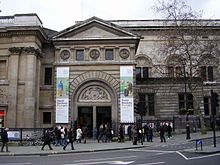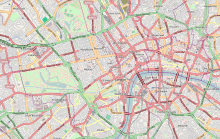National Portrait Gallery, London
The English used in this article or section may not be easy for everybody to understand. (May 2023) |
The National Portrait Gallery (NPG) is an art gallery in London. It holds a collection of portraits of historically important and famous British people. It was the first portrait gallery in the world when it opened in 1856.[6]
 | |
 Entrance to the National Portrait Gallery | |
Location of the National Portrait Gallery in Central London | |
| Established | 1856 |
|---|---|
| Location | St Martin's Place, WC2H 0HE, London, United Kingdom |
| Coordinates | 51°30′34″N 0°07′41″W / 51.5094°N 0.1281°W |
| Collection size | 220,000 portraits[1] |
| Visitors | 1,619,694 (2019)[2][3][4]
|
| Director | Nicholas Cullinan (2015 - )[5] |
| Public transit access | Charing Cross Embankment Leicester Square |
| Website | www.npg.org.uk |
The gallery moved in 1896 to its current site at St Martin's Place, off Trafalgar Square, next to the National Gallery. It has been expanded twice since then. The National Portrait Gallery also has three regional outposts. It is not connected to the Scottish National Portrait Gallery in Edinburgh. The NPG is a quango sponsored by the Department for Culture, Media and Sport.
The collection
changeThe gallery houses portraits of historically important and famous British people, selected on the basis of the significance of the sitter, such as royalty,[7] not that of the artist. The collection includes photographs and caricatures as well as paintings, drawings and sculpture.[8]
One of its best-known images is the 'Chandos portrait', the most famous portrait of William Shakespeare[9] although there is some uncertainty about whether the painting actually is of the playwright.[10]
Not all of the portraits are exceptional artistically, although there are self-portraits by William Hogarth, Sir Joshua Reynolds and other British artists of note. Some, such as the group portrait of the participants in the Somerset House Conference of 1604, are important historical documents in their own right. Often, the curiosity value is greater than the artistic worth of a work, as in the case of the portrait of Edward VI by William Scrots, Patrick Brontë's painting of his sisters Charlotte, Emily and Anne, or a sculpture of Queen Victoria and Prince Albert in medieval costume. Portraits of living figures were allowed from 1969.
In addition to its permanent galleries of historical portraits, the National Portrait Gallery exhibits a rapidly changing collection of contemporary work,[11] stages exhibitions of portrait art by individual artists and hosts the annual BP Portrait Prize competition.
The Gallery has many portrait busts by sculptors. The sculptors are mostly British or resident in Britain, and the subjects are British. Sculptors include poineers of modern sculpture such as Sir Jacob Epstein (14 examples), Dame Elizabeth Frink (5 examples), Sir Eduardo Paolozzi (four self-portrait busts).
References
change- ↑ "Explore our Collection - National Portrait Gallery".
- ↑ "ALVA – Association of Leading Visitor Attractions". www.alva.org.uk. Retrieved 23 October 2020.
- ↑ Top 100 Art Museum Attendance, The Art Newspaper, 2015. Retrieved on 10 October 2015.
- ↑ "Visits made in 2009". Association of Leading Visitor Attractions. Archived from the original on 31 Oct 2010. Retrieved 21 May 2010.
- ↑ Pes, Javier (6 January 2015). "National Portrait Gallery lures Met curator back to London". The Art Newspaper. Retrieved 6 January 2015.
- ↑ "National Portrait Gallery". ARTINFO. 2008. Retrieved 30 July 2008.
- ↑ museums, maxwell (November 19, 2023). "Anne Boleyn and Henry VIII's wives to star in National Portrait Gallery exhibition". maxwell museums.
- ↑ "Every great country must have its portrait gallery". Canada.com. 12 October 2006. Archived from the original on 25 August 2012. Retrieved 10 December 2011.
- ↑ National Portrait Gallery: Searching for Shakespeare. [1]
- ↑ Higgins, Charlotte (2006). "The only true painting of Shakespeare – probably". The Guardian. London. Retrieved 19 May 2010.
- ↑ Audley, Fiona. "SILENT TESTIMONY: Troubles paintings go on display at National Portrait Gallery". The Irish Post.
Other websites
change- Media related to National Portrait Gallery, London at Wikimedia Commons
- Official website
